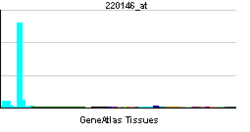TLR7
Toll-like receptor 7, also known as TLR7, is a protein that in humans is encoded by the TLR7 gene. Orthologs are found in mammals and birds.[1] It is a member of the toll-like receptor (TLR) family.
Function
The TLR family plays an important role in pathogen recognition and activation of innate immunity. TLRs are highly conserved from Drosophila to humans and share structural and functional similarities. They recognize pathogen-associated molecular patterns (PAMPs) that are expressed on infectious agents, and mediate the production of cytokines necessary for the development of effective immunity. The various TLRs exhibit different patterns of expression. This gene is predominantly expressed in lung, placenta, and spleen, and lies in close proximity to another family member, TLR8, on the human X chromosome.[2]
TLR7 recognises single-stranded RNA in endosomes, which is a common feature of viral genomes which are internalised by macrophages and dendritic cells.
Clinical significance
TLR7 has been shown to play a significant role in the pathogenesis of autoimmune disorders such as Systemic Lupus Erythematosus (SLE) as well as in the regulation of antiviral immunity. Although not yet fully elucidated, using an unbiased genome-scale screen with short hairpin RNA (shRNA), it has been demonstrated that the receptor TREML4 acts as an essential positive regulator of TLR7 signalling. In TREML4 -/- mice macrophages that are hyporesponsive to TLR7 agonists, macrophages fail to produce type I interferons due to impaired phosphorylation of the transcription factor STAT1 by the mitogen-activated protein kinase p38 and decreased recruitment of the adaptor MyD88 to TLR7. TREML4 deficiency reduced the production of inflammatory cytokines and autoantibodies in MRL/lpr mice, suggesting that TRL7 is a vital component of antiviral immunity and a predecessor factor in the pathogenesis of rheumatic diseases such as SLE.[4]
References
- ↑ Du X, Poltorak A, Wei Y, Beutler B (September 2000). "Three novel mammalian toll-like receptors: gene structure, expression, and evolution". Eur. Cytokine Netw. 11 (3): 362–71. PMID 11022119.
- ↑ "Entrez Gene: TLR7 toll-like receptor 7".
- ↑ Hemmi H, Kaisho T, Takeuchi O, Sato S, Sanjo H, Hoshino K, Horiuchi T, Tomizawa H, Takeda K, Akira S (February 2002). "Small anti-viral compounds activate immune cells via the TLR7 MyD88-dependent signaling pathway". Nat. Immunol. 3 (2): 196–200. doi:10.1038/ni758. PMID 11812998.
- ↑ ZG Ramirez-Ortiz, A Prasad, JW Griffith, WF Pendergraft III, GS Cowley, DE Root, M Tai, AD Luster, JE Khoury, N Hacohen, TK Means (6 April 2015). "The receptor TREML4 amplifies TLR7-mediated signaling during antiviral responses and autoimmunity". Nat. Immunol. 16: 495–504. doi:10.1038/ni.3143. PMID 25848864.
Further reading
- Lien E, Ingalls RR (2002). "Toll-like receptors". Crit. Care Med. 30 (1 Suppl): S1–11. doi:10.1097/00003246-200201001-00001. PMID 11782555.
- Kaisho T, Akira S (2002). "Toll-like receptors as adjuvant receptors". Biochim. Biophys. Acta 1589 (1): 1–13. doi:10.1016/S0167-4889(01)00182-3. PMID 11909637.
External links
- Toll-Like Receptor 7 at the US National Library of Medicine Medical Subject Headings (MeSH)
| ||||||||||||||||||||||||||||||||||||||
